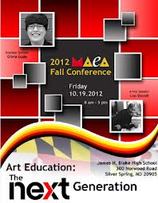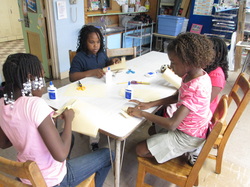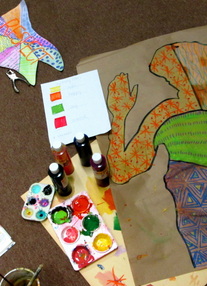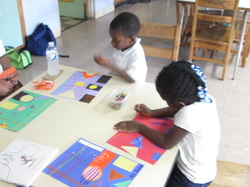
Photo courtesy of marylandarteducationassociation.ning.com
Today I was invigorated by ideas and people at the Maryland Art Education Association (MAEA) conference. I saw peers, former professors, and art teachers from around Maryland. These conferences both spark new and exciting ideas to use in the classroom and also give a sense of comradery among educators. The experiences from today, further validate the importance of my profession.
Olivia Gude, one of my favorite people in the field, was there as bold as ever, discussing art education in post modern times. I love the way that Olivia allows relationships to be built between students and their artworks and students and their peers. To provide examples of this I will describe a brief part of her workshop that I attended.
We entered the space and Olivia asked us to take four colored sheets of paper, one pastel, and light and dark pencil from the back of the room. The topic of this workshop is 'The Dirty Curriculum' (intriguing title, right?). When we sat down we were asked to crinkle up our four sheets of paper, and then smooth them out. We had a discussion about the meaning of the word 'dirty'. Together we observed images and unpacked ways that the objects we were seeing could be associated to it's meaning. Sharing stories from our lives we described times when we had made a mess and got in trouble and times when we made a mess on purpose. Some also told how they had gone without cleaning a room, washing jeans, and brushing teeth. After our discussion, we picked up our paper again and rubbed it on our heads, face and feet. Searching among our own objects that we had happened to have brought to the session, we were challenged to stain our surface in any way we could. There were some people stuffing the paper in their mouths, some taking soil from near by plants, I had some blue mascara (I'm not sure why) that I used. This physical interaction with the material, automatically took away the 'fear of the blank slate' feeling. We were forced, in a very short time frame, to become familiar with the material. In a classroom setting this method can break that barrier for students who are scared of being unable to make the 'perfect' work of art, and create a NEW kind of interaction!
Proceeding with the workshop, we created narrative ripped paper collages that told a story about a time that we were messy. Before we glued our collage pieces down we were told to ask a peer to critique and offer additional suggestions to ensure strong compositions. There was trust build in this interaction by giving a peer the final say that our work was complete. Relying on others, talking about artwork together, physically interacting with materials, all of these encounters allowed us as participants to feel safe and comfortable with the art materials and with each other in a very brief amount of time.
Thank you Olivia Gude for a thought provoking workshop!

Last week I spoke of creating an environment for my classes. I've noticed that there is a difference between creating and environment and maintaining one. This week in one of my classes there was a severe lack of community and respect. I've learned a lot from this past week.
Developing the culture of my classroom is what is most important to me right now in my teaching. For me, it has been relatively simple to write my teaching philosophy based on my own personal experiences and core values. I believe that children should learn and grow in a safe and nurturing environment. They should be guided through experiences that enable the development of their art vocabulary and skills. With these tools children will have what they need to express and discuss their ideas. I further think that students should take an active role in their own educational experience by asking questions, investigating ideas, and arriving at possible outcomes.
The challenge that I am facing, as a new teacher working in an urban environment, is defining the culture and climate of my art classroom. I need to figure out how my teaching philosophy melds with who my students are, what they know, and what they need. On Wednesday I had a rough class. There were many contributers to the disorganized chaotic outcome. In the first half of class I had to shut down the art project because I was concerned for student safety. I didn't have a back up plan ready to go, and I was flustered by the arguments and frustrations of my students. A teacher from across the hall came in and loudly projected her voice at my class telling them to be quiet. It was embarrassing for me to feel out of control. I have now realized, in retrospect, that I had not yet spent time building a community. The children don't know me, and I really don't know them either.
Teaching is a reflective practice: doing, observing, reflecting, refining, and then doing again. Reflective practices allows for growth. This week there was a large lack of community in my class and next week I am going back to spend time with my class re-identifying expectations, and exploring how we want to feel in our art classroom . Kids will create two drawings of themselves, one illustrating what makes them upset, the other showing what makes them feel safe and happy. We will share these as a group and discuss the ways that we individually and collectively can make each other feel good about making artwork.
I know that my teaching philosophy will morph over time and with new experiences, but I will strive to first develop and then maintain that safe and respectful environment.
I have so many great art projects planned that centralize around the themes of dreams, self, school and community. But I know that the art making will only be productive and meaningful if students can feel safe and free to express themselves.

Today is the first day of the after-school enrichment program! I am excited to begin teaching and getting to know my kids. The lessons that I have planned allow room for creativity and personal expression so that I can begin understand what values these students find important and understanding their processes of thinking. After this first week, when I will be teaching grades Pre-K through 8, I will have more of an understanding of what ideas to focus on and I can concretely map out the curriculum. This is an adventure. I'm dedicated and open to the possibilities that will be cultivated this year. This week is a really about developing a classroom community, getting to know my students, being open about who I am, and making art together. We'll be setting up the stage for what is to come.
I'm going to attempt to post my lesson plans at the conclusion of each week with reflections on strengths and challenges. This will both enable me to process and debrief from the week, modify my lessons for next time I teach them, and it will become a resource for other artist/teachers.
But for now....a couple more things to prepare, and HERE. WE. GO.... ------->




 RSS Feed
RSS Feed